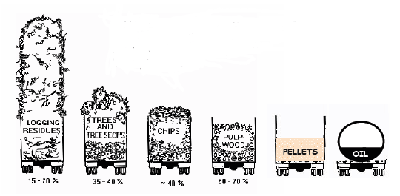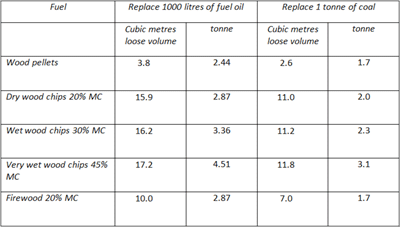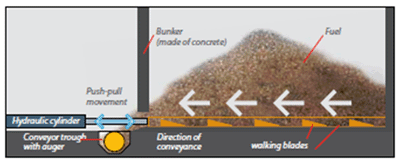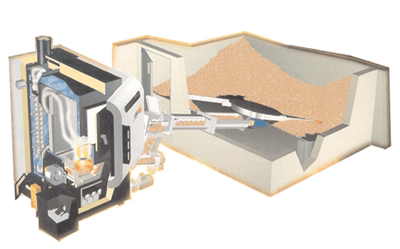At the outset it should be remembered that the energy density of wood fuels is much lower than that of fuel oil or coal as illustrated in Figure 4.

Figure 4 Energy density of different forest fuels at a given moisture content
This means that a lot more storage space is needed to store an amount of wood fuel of an equivalent energy value. In Table 1 one can see how much more storage space is needed to replace a certain amount of fossil fuel.

Table 1. Storage space required for different fuels
From the table it is clear that to replace 1 cubic metre of oil (1000 litres), one would need a storage space of 3.8 cubic metres for wood pellets or 16-17 cubic metres for wood chips, depending on the moisture content. For firewood one would need 10 cubic metres stacked volume.
The fuel storage space should be as close to the boiler as possible to avoid long transfer systems. It should be well ventilated and be fully moisture-proof from the outside.
Another very important point, and one that is often overlooked, is that the storage system should be easy to reach for supply vehicles, so that the delivery time and handling costs can be kept as low as possible.
For wood pellets a simpler storage tank can be used than for wood chips, because wood pellets flow much more easily than wood chips. The German Wood Pellet Institute has written an excellent guide on storage of wood pellets. This booklet has been translated and is available in PDF format by clicking here.
The volume of the fuel storage should be adapted to the fuel consumption but also taking into account the delivery costs of the fuel in consideration. For the supplier it will cost about the same to deliver 3 tonnes of fuel as for 1 tonne, meaning that the 1 tonne delivery is considerably more expensive per tonne delivered. In general, with wood fuels one should not store more than one year’s consumption at any one time. At the end of the heating season one can clean the fuel storage space and then buy fuel well before the season starts again. At that time of the year, fuel tends to be cheaper than at a time when everyone needs fuel supplied.
The fuel storage system of a wood chip burning installation is normally equipped with a forwarding system that delivers the chips to the handling system. This can be either in the form of a type of a walking-floor that pushes the fuel out onto an auger (Figure 5) or by a rotary arm under the fuel that pushes the fuel to an auger (see Figure 6).

Figure 5 Principle of a walking-floor feeding system

Figure 6 Rotary arm feeding system under the fuel
The advantage of a walking-floor system is that it is not as prone to blockages as the rotary system. Since the walking-floor delivers the fuel onto an auger, one can simply open the auger box and remove the blocking oversize particle. In the rotary system, one has to remove all the fuel on top of the auger before one can remove the blockage.
Also, the rotary system is less suitable for rectangular storage tanks, because the arms will leave pillars of fuel in the corners, where the fuel can clump together and be attacked by fungi, because they are a long time in the same place. Cleaning of the fuel storage system is needed at least once a year, ideally before a delivery. Before any storage system is entered or cleaned it must be well ventilated in advance.
